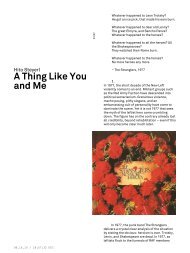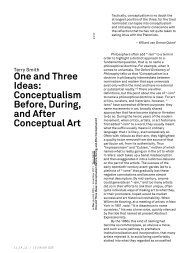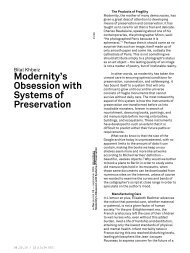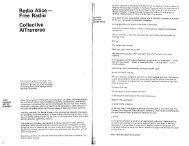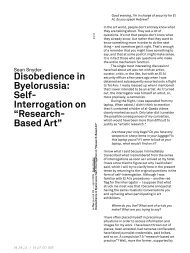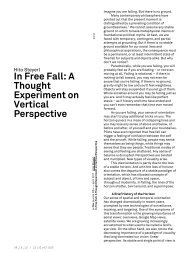In Defense of the Poor Image - e-flux Layout Generator
In Defense of the Poor Image - e-flux Layout Generator
In Defense of the Poor Image - e-flux Layout Generator
You also want an ePaper? Increase the reach of your titles
YUMPU automatically turns print PDFs into web optimized ePapers that Google loves.
Hito Steyerl<br />
<strong>In</strong> <strong>Defense</strong> <strong>of</strong><br />
<strong>the</strong> <strong>Poor</strong> <strong>Image</strong><br />
05.11.11 / 11:04:46 EDT<br />
01/09<br />
e-<strong>flux</strong> journal #10 — november 2009 Hito Steyerl<br />
<strong>In</strong> <strong>Defense</strong> <strong>of</strong> <strong>the</strong> <strong>Poor</strong> <strong>Image</strong><br />
The poor image is a copy in motion. Its quality is<br />
bad, its resolution substandard. As it<br />
accelerates, it deteriorates. It is a ghost <strong>of</strong> an<br />
image, a preview, a thumbnail, an errant idea, an<br />
itinerant image distributed for free, squeezed<br />
through slow digital connections, compressed,<br />
reproduced, ripped, remixed, as well as copied<br />
and pasted into o<strong>the</strong>r channels <strong>of</strong> distribution.<br />
The poor image is a rag or a rip; an AVI or a<br />
JPEG, a lumpen proletarian in <strong>the</strong> class society<br />
<strong>of</strong> appearances, ranked and valued according to<br />
its resolution. The poor image has been<br />
uploaded, downloaded, shared, reformatted, and<br />
reedited. It transforms quality into accessibility,<br />
exhibition value into cult value, films into clips,<br />
contemplation into distraction. The image is<br />
liberated from <strong>the</strong> vaults <strong>of</strong> cinemas and<br />
archives and thrust into digital uncertainty, at<br />
<strong>the</strong> expense <strong>of</strong> its own substance. The poor<br />
image tends towards abstraction: it is a visual<br />
idea in its very becoming.<br />
The poor image is an illicit fifth-generation<br />
bastard <strong>of</strong> an original image. Its genealogy is<br />
dubious. Its filenames are deliberately<br />
misspelled. It <strong>of</strong>ten defies patrimony, national<br />
culture, or indeed copyright. It is passed on as a<br />
lure, a decoy, an index, or as a reminder <strong>of</strong> its<br />
former visual self. It mocks <strong>the</strong> promises <strong>of</strong><br />
digital technology. Not only is it <strong>of</strong>ten degraded<br />
to <strong>the</strong> point <strong>of</strong> being just a hurried blur, one even<br />
doubts whe<strong>the</strong>r it could be called an image at all.<br />
Only digital technology could produce such a<br />
dilapidated image in <strong>the</strong> first place.<br />
<strong>Poor</strong> images are <strong>the</strong> contemporary<br />
Wretched <strong>of</strong> <strong>the</strong> Screen, <strong>the</strong> debris <strong>of</strong> audiovisual<br />
production, <strong>the</strong> trash that washes up on <strong>the</strong><br />
digital economies’ shores. They testify to <strong>the</strong><br />
violent dislocation, transferrals, and<br />
displacement <strong>of</strong> images – <strong>the</strong>ir acceleration and<br />
circulation within <strong>the</strong> vicious cycles <strong>of</strong><br />
audiovisual capitalism. <strong>Poor</strong> images are dragged<br />
around <strong>the</strong> globe as commodities or <strong>the</strong>ir<br />
effigies, as gifts or as bounty. They spread<br />
pleasure or death threats, conspiracy <strong>the</strong>ories or<br />
bootlegs, resistance or stultification. <strong>Poor</strong><br />
images show <strong>the</strong> rare, <strong>the</strong> obvious, and <strong>the</strong><br />
unbelievable – that is, if we can still manage to<br />
decipher it.<br />
1. Low Resolutions<br />
<strong>In</strong> one <strong>of</strong> Woody Allen’s films <strong>the</strong> main character<br />
is out <strong>of</strong> focus. 1 It’s not a technical problem but<br />
some sort <strong>of</strong> disease that has befallen him: his<br />
image is consistently blurred. Since Allen’s<br />
character is an actor, this becomes a major<br />
problem: he is unable to find work. His lack <strong>of</strong><br />
definition turns into a material problem. Focus is<br />
identified as a class position, a position <strong>of</strong> ease<br />
and privilege, while being out <strong>of</strong> focus lowers<br />
one’s value as an image.
02/09<br />
Shoveling pirated DVDs in Taiyuan, Shanxi province, China, April 20, 2008.<br />
05.11.11 / 11:04:46 EDT
The contemporary hierarchy <strong>of</strong> images,<br />
however, is not only based on sharpness, but<br />
also and primarily on resolution. Just look at any<br />
electronics store and this system, described by<br />
Harun Farocki in a notable 2007 interview,<br />
becomes immediately apparent. 2 <strong>In</strong> <strong>the</strong> class<br />
society <strong>of</strong> images, cinema takes on <strong>the</strong> role <strong>of</strong> a<br />
flagship store. <strong>In</strong> flagship stores high-end<br />
products are marketed in an upscale<br />
environment. More affordable derivatives <strong>of</strong> <strong>the</strong><br />
same images circulate as DVDs, on broadcast<br />
television or online, as poor images.<br />
Obviously, a high-resolution image looks<br />
more brilliant and impressive, more mimetic and<br />
magic, more scary and seductive than a poor<br />
one. It is more rich, so to speak. Now, even<br />
consumer formats are increasingly adapting to<br />
<strong>the</strong> tastes <strong>of</strong> cineastes and es<strong>the</strong>tes, who<br />
insisted on 35 mm film as a guarantee <strong>of</strong> pristine<br />
visuality. The insistence upon analog film as <strong>the</strong><br />
sole medium <strong>of</strong> visual importance resounded<br />
throughout discourses on cinema, almost<br />
regardless <strong>of</strong> <strong>the</strong>ir ideological inflection. It never<br />
mattered that <strong>the</strong>se high-end economies <strong>of</strong> film<br />
production were (and still are) firmly anchored in<br />
systems <strong>of</strong> national culture, capitalist studio<br />
production, <strong>the</strong> cult <strong>of</strong> mostly male genius, and<br />
<strong>the</strong> original version, and thus are <strong>of</strong>ten<br />
03/09<br />
conservative in <strong>the</strong>ir very structure. Resolution<br />
was fetishized as if its lack amounted to<br />
castration <strong>of</strong> <strong>the</strong> author. The cult <strong>of</strong> film gauge<br />
dominated even independent film production.<br />
The rich image established its own set <strong>of</strong><br />
hierarchies, with new technologies <strong>of</strong>fering more<br />
and more possibilities to creatively degrade it.<br />
2. Resurrection (as <strong>Poor</strong> <strong>Image</strong>s)<br />
But insisting on rich images also had more<br />
serious consequences. A speaker at a recent<br />
conference on <strong>the</strong> film essay refused to show<br />
clips from a piece by Humphrey Jennings<br />
because no proper film projection was available.<br />
Although <strong>the</strong>re was at <strong>the</strong> speaker’s disposal a<br />
perfectly standard DVD player and video<br />
projector, <strong>the</strong> audience was left to imagine what<br />
those images might have looked like.<br />
<strong>In</strong> this case <strong>the</strong> invisibility <strong>of</strong> <strong>the</strong> image was<br />
more or less voluntary and based on aes<strong>the</strong>tic<br />
premises. But it has a much more general<br />
equivalent based on <strong>the</strong> consequences <strong>of</strong><br />
neoliberal policies. Twenty or even thirty years<br />
ago, <strong>the</strong> neoliberal restructuring <strong>of</strong> media<br />
production began slowly obscuring noncommercial<br />
imagery, to <strong>the</strong> point where<br />
experimental and essayistic cinema became<br />
almost invisible. As it became prohibitively<br />
Nine 35mm film frames from Stan Brakhage’s Existence is Song, 1987.<br />
05.11.11 / 11:04:46 EDT
expensive to keep <strong>the</strong>se works circulating in<br />
cinemas, so were <strong>the</strong>y also deemed too marginal<br />
to be broadcast on television. Thus <strong>the</strong>y slowly<br />
disappeared not just from cinemas, but from <strong>the</strong><br />
public sphere as well. Video essays and<br />
experimental films remained for <strong>the</strong> most part<br />
unseen save for some rare screenings in<br />
metropolitan film museums or film clubs,<br />
projected in <strong>the</strong>ir original resolution before<br />
disappearing again into <strong>the</strong> darkness <strong>of</strong> <strong>the</strong><br />
archive.<br />
This development was <strong>of</strong> course connected<br />
to <strong>the</strong> neoliberal radicalization <strong>of</strong> <strong>the</strong> concept <strong>of</strong><br />
culture as commodity, to <strong>the</strong> commercialization<br />
<strong>of</strong> cinema, its dispersion into multiplexes, and<br />
<strong>the</strong> marginalization <strong>of</strong> independent filmmaking.<br />
It was also connected to <strong>the</strong> restructuring <strong>of</strong><br />
global media industries and <strong>the</strong> establishment <strong>of</strong><br />
monopolies over <strong>the</strong> audiovisual in certain<br />
countries or territories. <strong>In</strong> this way, resistant or<br />
non-conformist visual matter disappeared from<br />
<strong>the</strong> surface into an underground <strong>of</strong> alternative<br />
archives and collections, kept alive only by a<br />
network <strong>of</strong> committed organizations and<br />
individuals, who would circulate bootlegged VHS<br />
copies amongst <strong>the</strong>mselves. Sources for <strong>the</strong>se<br />
were extremely rare – tapes moved from hand to<br />
hand, depending on word <strong>of</strong> mouth, within circles<br />
04/09<br />
<strong>of</strong> friends and colleagues. With <strong>the</strong> possibility to<br />
stream video online, this condition started to<br />
dramatically change. An increasing number <strong>of</strong><br />
rare materials reappeared on publicly accessible<br />
platforms, some <strong>of</strong> <strong>the</strong>m carefully curated<br />
(Ubuweb) and some just a pile <strong>of</strong> stuff (YouTube).<br />
At present, <strong>the</strong>re are at least twenty<br />
torrents <strong>of</strong> Chris Marker’s film essays available<br />
online. If you want a retrospective, you can have<br />
it. But <strong>the</strong> economy <strong>of</strong> poor images is about more<br />
than just downloads: you can keep <strong>the</strong> files,<br />
watch <strong>the</strong>m again, even reedit or improve <strong>the</strong>m if<br />
you think it necessary. And <strong>the</strong> results circulate.<br />
Blurred AVI files <strong>of</strong> half-forgotten masterpieces<br />
are exchanged on semi-secret P2P platforms.<br />
Clandestine cell-phone videos smuggled out <strong>of</strong><br />
museums are broadcast on YouTube. DVDs <strong>of</strong><br />
artists’ viewing copies are bartered. 3 Many works<br />
<strong>of</strong> avant-garde, essayistic, and non-commercial<br />
cinema have been resurrected as poor images.<br />
Whe<strong>the</strong>r <strong>the</strong>y like it or not.<br />
3. Privatization and Piracy<br />
That rare prints <strong>of</strong> militant, experimental, and<br />
classical works <strong>of</strong> cinema as well as video art<br />
reappear as poor images is significant on<br />
ano<strong>the</strong>r level. Their situation reveals much more<br />
than <strong>the</strong> content or appearance <strong>of</strong> <strong>the</strong> images<br />
05.11.11 / 11:04:46 EDT
Chris Marker’s virtual home on Second Life, May 29, 2009.<br />
05.11.11 / 11:04:46 EDT
<strong>the</strong>mselves: it also reveals <strong>the</strong> conditions <strong>of</strong> <strong>the</strong>ir<br />
marginalization, <strong>the</strong> constellation <strong>of</strong> social<br />
forces leading to <strong>the</strong>ir online circulation as poor<br />
images. 4 <strong>Poor</strong> images are poor because <strong>the</strong>y are<br />
not assigned any value within <strong>the</strong> class society <strong>of</strong><br />
images – <strong>the</strong>ir status as illicit or degraded grants<br />
<strong>the</strong>m exemption from its criteria. Their lack <strong>of</strong><br />
resolution attests to <strong>the</strong>ir appropriation and<br />
displacement. 5<br />
Obviously, this condition is not only<br />
connected to <strong>the</strong> neoliberal restructuring <strong>of</strong><br />
media production and digital technology; it also<br />
has to do with <strong>the</strong> post-socialist and<br />
postcolonial restructuring <strong>of</strong> nation states, <strong>the</strong>ir<br />
cultures, and <strong>the</strong>ir archives. While some nation<br />
states are dismantled or fall apart, new cultures<br />
and traditions are invented and new histories<br />
created. This obviously also affects film archives<br />
– in many cases, a whole heritage <strong>of</strong> film prints<br />
is left without its supporting framework <strong>of</strong><br />
national culture. As I once observed in <strong>the</strong> case<br />
<strong>of</strong> a film museum in Sarajevo, <strong>the</strong> national<br />
archive can find its next life in <strong>the</strong> form <strong>of</strong> a<br />
video-rental store. 6 Pirate copies seep out <strong>of</strong><br />
such archives through disorganized privatization.<br />
On <strong>the</strong> o<strong>the</strong>r hand, even <strong>the</strong> British Library sells<br />
<strong>of</strong>f its contents online at astronomical prices.<br />
As Kodwo Eshun has noted, poor images<br />
circulate partly in <strong>the</strong> void left by state-cinema<br />
organizations who find it too difficult to operate<br />
as a 16/35-mm archive or to maintain any kind <strong>of</strong><br />
distribution infrastructure in <strong>the</strong> contemporary<br />
era. 7 From this perspective, <strong>the</strong> poor image<br />
reveals <strong>the</strong> decline and degradation <strong>of</strong> <strong>the</strong> film<br />
essay, or indeed any experimental and noncommercial<br />
cinema, which in many places was<br />
made possible because <strong>the</strong> production <strong>of</strong> culture<br />
was considered a task <strong>of</strong> <strong>the</strong> state. Privatization<br />
<strong>of</strong> media production gradually grew more<br />
important than state controlled/sponsored<br />
media production. But, on <strong>the</strong> o<strong>the</strong>r hand, <strong>the</strong><br />
rampant privatization <strong>of</strong> intellectual content,<br />
along with online marketing and<br />
commodification, also enable piracy and<br />
appropriation; it gives rise to <strong>the</strong> circulation <strong>of</strong><br />
poor images.<br />
4. Imperfect Cinema<br />
The emergence <strong>of</strong> poor images reminds one <strong>of</strong> a<br />
classic Third Cinema manifesto, For an Imperfect<br />
Cinema, by Juan García Espinosa, written in<br />
Cuba in <strong>the</strong> late 1960s. 8 Espinosa argues for an<br />
imperfect cinema because, in his words, “perfect<br />
cinema – technically and artistically masterful –<br />
is almost always reactionary cinema.” The<br />
imperfect cinema is one that strives to overcome<br />
<strong>the</strong> divisions <strong>of</strong> labor within class society. It<br />
merges art with life and science, blurring <strong>the</strong><br />
distinction between consumer and producer,<br />
audience and author. It insists upon its own<br />
05.11.11 / 11:04:46 EDT<br />
06/09<br />
e-<strong>flux</strong> journal #10 — november 2009 Hito Steyerl<br />
<strong>In</strong> <strong>Defense</strong> <strong>of</strong> <strong>the</strong> <strong>Poor</strong> <strong>Image</strong><br />
imperfection, is popular but not consumerist,<br />
committed without becoming bureaucratic.<br />
<strong>In</strong> his manifesto, Espinosa also reflects on<br />
<strong>the</strong> promises <strong>of</strong> new media. He clearly predicts<br />
that <strong>the</strong> development <strong>of</strong> video technology will<br />
jeopardize <strong>the</strong> elitist position <strong>of</strong> traditional<br />
filmmakers and enable some sort <strong>of</strong> mass film<br />
production: an art <strong>of</strong> <strong>the</strong> people. Like <strong>the</strong><br />
economy <strong>of</strong> poor images, imperfect cinema<br />
diminishes <strong>the</strong> distinctions between author and<br />
audience and merges life and art. Most <strong>of</strong> all, its<br />
visuality is resolutely compromised: blurred,<br />
amateurish, and full <strong>of</strong> artifacts.<br />
<strong>In</strong> some way, <strong>the</strong> economy <strong>of</strong> poor images<br />
corresponds to <strong>the</strong> description <strong>of</strong> imperfect<br />
cinema, while <strong>the</strong> description <strong>of</strong> perfect cinema<br />
represents ra<strong>the</strong>r <strong>the</strong> concept <strong>of</strong> cinema as a<br />
flagship store. But <strong>the</strong> real and contemporary<br />
imperfect cinema is also much more ambivalent<br />
and affective than Espinosa had anticipated. On<br />
<strong>the</strong> one hand, <strong>the</strong> economy <strong>of</strong> poor images, with<br />
its immediate possibility <strong>of</strong> worldwide<br />
distribution and its ethics <strong>of</strong> remix and<br />
appropriation, enables <strong>the</strong> participation <strong>of</strong> a<br />
much larger group <strong>of</strong> producers than ever before.<br />
But this does not mean that <strong>the</strong>se opportunities<br />
are only used for progressive ends. Hate speech,<br />
spam, and o<strong>the</strong>r rubbish make <strong>the</strong>ir way through<br />
digital connections as well. Digital<br />
communication has also become one <strong>of</strong> <strong>the</strong> most<br />
contested markets – a zone that has long been<br />
subjected to an ongoing original accumulation<br />
and to massive (and, to a certain extent,<br />
successful) attempts at privatization.<br />
The networks in which poor images<br />
circulate thus constitute both a platform for a<br />
fragile new common interest and a battleground<br />
for commercial and national agendas. They<br />
contain experimental and artistic material, but<br />
also incredible amounts <strong>of</strong> porn and paranoia.<br />
While <strong>the</strong> territory <strong>of</strong> poor images allows access<br />
to excluded imagery, it is also permeated by <strong>the</strong><br />
most advanced commodification techniques.<br />
While it enables <strong>the</strong> users’ active participation in<br />
<strong>the</strong> creation and distribution <strong>of</strong> content, it also<br />
drafts <strong>the</strong>m into production. Users become <strong>the</strong><br />
editors, critics, translators, and (co-)authors <strong>of</strong><br />
poor images.<br />
<strong>Poor</strong> images are thus popular images –<br />
images that can be made and seen by <strong>the</strong> many.<br />
They express all <strong>the</strong> contradictions <strong>of</strong> <strong>the</strong><br />
contemporary crowd: its opportunism,<br />
narcissism, desire for autonomy and creation, its<br />
inability to focus or make up its mind, its<br />
constant readiness for transgression and<br />
simultaneous submission. 9 Altoge<strong>the</strong>r, poor<br />
images present a snapshot <strong>of</strong> <strong>the</strong> affective<br />
condition <strong>of</strong> <strong>the</strong> crowd, its neurosis, paranoia,<br />
and fear, as well as its craving for intensity, fun,<br />
and distraction. The condition <strong>of</strong> <strong>the</strong> images
speaks not only <strong>of</strong> countless transfers and<br />
reformattings, but also <strong>of</strong> <strong>the</strong> countless people<br />
who cared enough about <strong>the</strong>m to convert <strong>the</strong>m<br />
over and over again, to add subtitles, reedit, or<br />
upload <strong>the</strong>m.<br />
<strong>In</strong> this light, perhaps one has to redefine <strong>the</strong><br />
value <strong>of</strong> <strong>the</strong> image, or, more precisely, to create a<br />
new perspective for it. Apart from resolution and<br />
exchange value, one might imagine ano<strong>the</strong>r form<br />
<strong>of</strong> value defined by velocity, intensity, and<br />
spread. <strong>Poor</strong> images are poor because <strong>the</strong>y are<br />
heavily compressed and travel quickly. They lose<br />
matter and gain speed. But <strong>the</strong>y also express a<br />
condition <strong>of</strong> dematerialization, shared not only<br />
with <strong>the</strong> legacy <strong>of</strong> conceptual art but above all<br />
with contemporary modes <strong>of</strong> semiotic<br />
production. 10 Capital’s semiotic turn, as<br />
described by Felix Guattari, 11 plays in favor <strong>of</strong> <strong>the</strong><br />
creation and dissemination <strong>of</strong> compressed and<br />
flexible data packages that can be integrated<br />
into ever-newer combinations and sequences. 12<br />
This flattening-out <strong>of</strong> visual content – <strong>the</strong><br />
concept-in-becoming <strong>of</strong> <strong>the</strong> images – positions<br />
<strong>the</strong>m within a general informational turn, within<br />
economies <strong>of</strong> knowledge that tear images and<br />
<strong>the</strong>ir captions out <strong>of</strong> context into <strong>the</strong> swirl <strong>of</strong><br />
permanent capitalist deterritorialization. 13 The<br />
history <strong>of</strong> conceptual art describes this<br />
07/09<br />
dematerialization <strong>of</strong> <strong>the</strong> art object first as a<br />
resistant move against <strong>the</strong> fetish value <strong>of</strong><br />
visibility. Then, however, <strong>the</strong> dematerialized art<br />
object turns out to be perfectly adapted to <strong>the</strong><br />
semioticization <strong>of</strong> capital, and thus to <strong>the</strong><br />
conceptual turn <strong>of</strong> capitalism. 14 <strong>In</strong> a way, <strong>the</strong><br />
poor image is subject to a similar tension. On <strong>the</strong><br />
one hand, it operates against <strong>the</strong> fetish value <strong>of</strong><br />
high resolution. On <strong>the</strong> o<strong>the</strong>r hand, this is<br />
precisely why it also ends up being perfectly<br />
integrated into an information capitalism thriving<br />
on compressed attention spans, on impression<br />
ra<strong>the</strong>r than immersion, on intensity ra<strong>the</strong>r than<br />
contemplation, on previews ra<strong>the</strong>r than<br />
screenings.<br />
5. Comrade, what is your visual bond<br />
today?<br />
But, simultaneously, a paradoxical reversal<br />
happens. The circulation <strong>of</strong> poor images creates<br />
a circuit, which fulfills <strong>the</strong> original ambitions <strong>of</strong><br />
militant and (some) essayistic and experimental<br />
cinema – to create an alternative economy <strong>of</strong><br />
images, an imperfect cinema existing inside as<br />
well as beyond and under commercial media<br />
streams. <strong>In</strong> <strong>the</strong> age <strong>of</strong> file-sharing, even<br />
marginalized content circulates again and<br />
reconnects dispersed worldwide audiences.<br />
Thomas Ruff, jpeg rl104, 2007.<br />
05.11.11 / 11:04:46 EDT
The poor image thus constructs anonymous<br />
global networks just as it creates a shared<br />
history. It builds alliances as it travels, provokes<br />
translation or mistranslation, and creates new<br />
publics and debates. By losing its visual<br />
substance it recovers some <strong>of</strong> its political punch<br />
and creates a new aura around it. This aura is no<br />
longer based on <strong>the</strong> permanence <strong>of</strong> <strong>the</strong><br />
“original,” but on <strong>the</strong> transience <strong>of</strong> <strong>the</strong> copy. It is<br />
no longer anchored within a classical public<br />
sphere mediated and supported by <strong>the</strong> frame <strong>of</strong><br />
<strong>the</strong> nation state or corporation, but floats on <strong>the</strong><br />
surface <strong>of</strong> temporary and dubious data pools. 15<br />
By drifting away from <strong>the</strong> vaults <strong>of</strong> cinema, it is<br />
propelled onto new and ephemeral screens<br />
stitched toge<strong>the</strong>r by <strong>the</strong> desires <strong>of</strong> dispersed<br />
spectators.<br />
The circulation <strong>of</strong> poor images thus creates<br />
“visual bonds,” as Dziga Vertov once called<br />
<strong>the</strong>m. 16 This “visual bond” was, according to<br />
Vertov, supposed to link <strong>the</strong> workers <strong>of</strong> <strong>the</strong> world<br />
with each o<strong>the</strong>r. 17 He imagined a sort <strong>of</strong><br />
communist, visual, Adamic language that could<br />
not only inform or entertain, but also organize its<br />
viewers. <strong>In</strong> a sense, his dream has come true, if<br />
mostly under <strong>the</strong> rule <strong>of</strong> a global information<br />
capitalism whose audiences are linked almost in<br />
a physical sense by mutual excitement, affective<br />
attunement, and anxiety.<br />
But <strong>the</strong>re is also <strong>the</strong> circulation and<br />
production <strong>of</strong> poor images based on cell phone<br />
cameras, home computers, and unconventional<br />
forms <strong>of</strong> distribution. Its optical connections –<br />
collective editing, file sharing, or grassroots<br />
distribution circuits – reveal erratic and<br />
coincidental links between producers<br />
everywhere, which simultaneously constitute<br />
dispersed audiences.<br />
The circulation <strong>of</strong> poor images feeds into<br />
both capitalist media assembly lines and<br />
alternative audiovisual economies. <strong>In</strong> addition to<br />
a lot <strong>of</strong> confusion and stupefaction, it also<br />
possibly creates disruptive movements <strong>of</strong><br />
thought and affect. The circulation <strong>of</strong> poor<br />
images thus initiates ano<strong>the</strong>r chapter in <strong>the</strong><br />
historical genealogy <strong>of</strong> nonconformist<br />
information circuits: Vertov’s “visual bonds,” <strong>the</strong><br />
internationalist workers pedagogies that Peter<br />
Weiss described in The Aes<strong>the</strong>tics <strong>of</strong> Resistance,<br />
<strong>the</strong> circuits <strong>of</strong> Third Cinema and<br />
Tricontinentalism, <strong>of</strong> non-aligned filmmaking<br />
and thinking. The poor image – ambivalent as its<br />
status may be – thus takes its place in <strong>the</strong><br />
genealogy <strong>of</strong> carbon-copied pamphlets, cinetrain<br />
agit-prop films, underground video<br />
magazines and o<strong>the</strong>r nonconformist materials,<br />
which aes<strong>the</strong>tically <strong>of</strong>ten used poor materials.<br />
Moreover, it reactualizes many <strong>of</strong> <strong>the</strong> historical<br />
ideas associated with <strong>the</strong>se circuits, among<br />
o<strong>the</strong>rs Vertov’s idea <strong>of</strong> <strong>the</strong> visual bond.<br />
05.11.11 / 11:04:46 EDT<br />
08/09<br />
e-<strong>flux</strong> journal #10 — november 2009 Hito Steyerl<br />
<strong>In</strong> <strong>Defense</strong> <strong>of</strong> <strong>the</strong> <strong>Poor</strong> <strong>Image</strong><br />
Imagine somebody from <strong>the</strong> past with a<br />
beret asking you, “Comrade, what is your visual<br />
bond today?”<br />
You might answer: it is this link to <strong>the</strong><br />
present.<br />
6. Now!<br />
The poor image embodies <strong>the</strong> afterlife <strong>of</strong> many<br />
former masterpieces <strong>of</strong> cinema and video art. It<br />
has been expelled from <strong>the</strong> sheltered paradise<br />
that cinema seems to have once been. 18 After<br />
being kicked out <strong>of</strong> <strong>the</strong> protected and <strong>of</strong>ten<br />
protectionist arena <strong>of</strong> national culture, discarded<br />
from commercial circulation, <strong>the</strong>se works have<br />
become travelers in a digital no-man’s land,<br />
constantly shifting <strong>the</strong>ir resolution and format,<br />
speed and media, sometimes even losing names<br />
and credits along <strong>the</strong> way.<br />
Now many <strong>of</strong> <strong>the</strong>se works are back – as<br />
poor images, I admit. One could <strong>of</strong> course argue<br />
that this is not <strong>the</strong> real thing, but <strong>the</strong>n – please,<br />
anybody – show me this real thing.<br />
The poor image is no longer about <strong>the</strong> real<br />
thing – <strong>the</strong> originary original. <strong>In</strong>stead, it is about<br />
its own real conditions <strong>of</strong> existence: about<br />
swarm circulation, digital dispersion, fractured<br />
and flexible temporalities. It is about defiance<br />
and appropriation just as it is about conformism<br />
and exploitation.<br />
<strong>In</strong> short: it is about reality.<br />
×<br />
An earlier version <strong>of</strong> this text was improvised in a response at<br />
<strong>the</strong> “Essayfilm – Äs<strong>the</strong>tik und Aktualität” conference in<br />
Lüneburg, Germany, organized by Thomas Tode and Sven<br />
Kramer in 2007. The text benefitted tremendously from <strong>the</strong><br />
remarks and comments <strong>of</strong> Third Text guest editor Kodwo<br />
Eshun, who commissioned a longer version for an issue <strong>of</strong><br />
Third Text on Chris Marker and Third Cinema to appear in<br />
2010 (co-edited by Ros Grey). Ano<strong>the</strong>r substantial inspiration<br />
for this text was <strong>the</strong> exhibition “Dispersion” at <strong>the</strong> ICA in<br />
London (curated by Polly Staple in 2008), which included a<br />
brilliant reader edited by Staple and Richard Birkett. The text<br />
also benefitted greatly from Brian Kuan Wood’s editorial<br />
work.
Hito Steyerl is a filmmaker and writer. She teaches<br />
New Media Art at University <strong>of</strong> Arts Berlin and has<br />
recently participated in Documenta 12, Shanghai<br />
Biennial, and Rotterdam Film Festival.<br />
09/09<br />
1<br />
Deconstructing Harry, directed<br />
by Woody Allen (1997).<br />
2<br />
“Wer Gemälde wirklich sehen<br />
will, geht ja schließlich auch ins<br />
Museum,” Frankfurter<br />
Allgemeine Zeitung, June 14,<br />
2007. Conversation between<br />
Harun Farocki and Alexander<br />
Horwath.<br />
3<br />
Sven Lütticken’s excellent text<br />
“Viewing Copies: On <strong>the</strong> Mobility<br />
<strong>of</strong> Moving <strong>Image</strong>s,” in e-<strong>flux</strong><br />
journal, no. 8 (May 2009), drew<br />
my attention to this aspect <strong>of</strong><br />
poor images. See http://e<strong>flux</strong>.com/journal/vi<br />
ew/75.<br />
4<br />
Thanks to Kodwo Eshun for<br />
pointing this out.<br />
5<br />
Of course in some cases images<br />
with low resolution also appear<br />
in mainstream media<br />
environments (mainly news),<br />
where <strong>the</strong>y are associated with<br />
urgency, immediacy, and<br />
catastrophe – and are extremely<br />
valuable. See Hito Steyerl,<br />
“Documentary Uncertainty,” A<br />
Prior 15 (2007),<br />
http://magazines.documenta.d<br />
e/frontend/article.php?IdLan<br />
guage=1&NrArticle=584.<br />
See also Alan Sekula, “Reading<br />
an Archive: Photography<br />
between Labour and Capital,” in<br />
Visual Culture: The Reader, ed.<br />
Stuart Hall and Jessica Evans<br />
(London/New York: Routledge<br />
1999), 181–192.<br />
14<br />
See Alberro, Conceptual Art and<br />
<strong>the</strong> Politics <strong>of</strong> Publicity.<br />
15<br />
The Pirate Bay even seems to<br />
have tried acquiring <strong>the</strong><br />
extraterritorial oil platform <strong>of</strong><br />
Sealand in order to install its<br />
servers <strong>the</strong>re. See Jan Libbenga,<br />
“The Pirate Bay plans to buy<br />
Sealand,” The Register, January<br />
12, 2007,<br />
http://www.<strong>the</strong>register.co.uk<br />
/2007/01/12/pirate_bay_buys_<br />
island.<br />
16<br />
Dziga Vertov, “Kinopravda and<br />
Radiopravda,” in Kino-Eye: The<br />
Writings <strong>of</strong> Dziga Vertov, ed.<br />
Annette Michelson (Berkeley:<br />
University <strong>of</strong> California Press,<br />
1995), 52.<br />
17<br />
Vertov, “Kinopravda and<br />
Radiopravda,” 52.<br />
18<br />
At least from <strong>the</strong> perspective <strong>of</strong><br />
nostalgic delusion.<br />
6<br />
Hito Steyerl, “Politics <strong>of</strong> <strong>the</strong><br />
Archive: Translations in Film,”<br />
Transversal (March 2008),<br />
http://eipcp.net/transversal<br />
/0608/steyerl/en.<br />
7<br />
From correspondence with <strong>the</strong><br />
author via e-mail.<br />
e-<strong>flux</strong> journal #10 — november 2009 Hito Steyerl<br />
<strong>In</strong> <strong>Defense</strong> <strong>of</strong> <strong>the</strong> <strong>Poor</strong> <strong>Image</strong><br />
8<br />
Julio García Espinosa, “For an<br />
Imperfect Cinema,” trans.<br />
Julianne Burton, Jump Cut, no.<br />
20 (1979): 24–26.<br />
9<br />
See Paolo Virno, A Grammar <strong>of</strong><br />
<strong>the</strong> Multitude: For an Analysis <strong>of</strong><br />
Contemporary Forms <strong>of</strong> Life<br />
(Cambridge, MA: MIT Press,<br />
2004).<br />
10<br />
See Alex Alberro, Conceptual Art<br />
and <strong>the</strong> Politics <strong>of</strong><br />
Publicity(Cambridge, MA: MIT<br />
Press, 2003).<br />
11<br />
See Félix Guattari, “Capital as<br />
<strong>the</strong> <strong>In</strong>tegral <strong>of</strong> Power<br />
Formations,” in S<strong>of</strong>t Subversions<br />
(New York: Semiotext(e), 1996),<br />
202.<br />
12<br />
All <strong>the</strong>se developments are<br />
discussed in detail in an<br />
excellent text by Simon Sheikh,<br />
“Objects <strong>of</strong> Study or<br />
Commodification <strong>of</strong> Knowledge?<br />
Remarks on Artistic Research,”<br />
Art & Research 2, no. 2 (Spring<br />
2009),<br />
http://www.artandresearch.or<br />
g.uk/v2n2/sheikh.html.<br />
13<br />
05.11.11 / 11:04:46 EDT


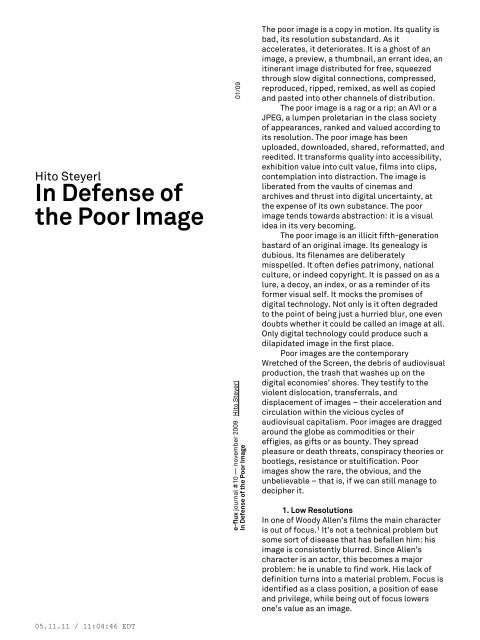
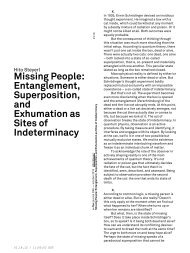
![Comrades of Time [PDF] - weskline . com](https://img.yumpu.com/50148218/1/190x253/comrades-of-time-pdf-weskline-com.jpg?quality=85)
